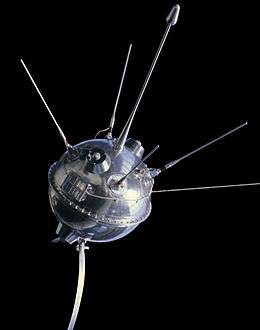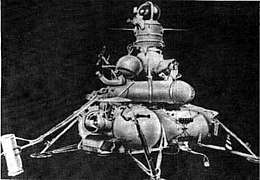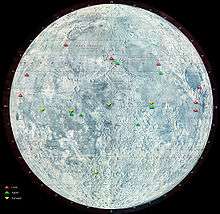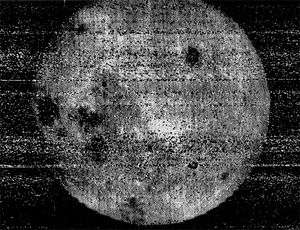Luna programme
| |||
Luna programme:
|
| Part of a series of articles on the |
| Soviet space program |
|---|
 |
The Luna programme (from the Russian word Луна "Luna" meaning "Lunar" or "Moon"), occasionally called Lunik or Lunnik by western media, was a series of robotic spacecraft missions sent to the Moon by the Soviet Union between 1959 and 1976. Fifteen were successful, each designed as either an orbiter or lander, and accomplished many firsts in space exploration. They also performed many experiments, studying the Moon's chemical composition, gravity, temperature, and radiation.
Twenty-four spacecraft were formally given the Luna designation, although more were launched. Those that failed to reach orbit were not publicly acknowledged at the time, and not assigned a Luna number. Those that failed in low Earth orbit were usually given Cosmos designations.[2] The estimated cost of the Luna programme was about $4.5 billion.
Achievements
Luna 1 (January 1959) missed its intended impact with the Moon and became the first spacecraft to fall into orbit around the Sun.
Luna 2 (September 1959) mission successfully hit the Moon's surface, becoming the first man-made object to reach the Moon.
Luna 3 (October 1959) rounded the Moon later that year, and returned the first photographs of its far side, which can never be seen from Earth.
Luna 9 (February 1966) became the first probe to achieve a soft landing on another planetary body. It returned five black and white stereoscopic circular panoramas, which were the first close-up shots of the Lunar surface.
Luna 10 (March 1966) became the first artificial satellite of the Moon.
Luna 17 (November 1970) and Luna 21 (January 1973) carried the Lunokhod vehicles, which roamed around on the Moon's terrain.
Another major achievement of the Luna programme, with Luna 16 (September 1970), Luna 20 (February 1972) and Luna 24 (August 1976), was the ability to collect samples of lunar soil and return them to Earth. The programme returned 0.326 kg of lunar samples. The Luna missions were the first space-exploration sample return missions to rely solely on advanced robotics.
Other notable missions
Luna 15 (July 1969), also designed to return soil samples from the lunar surface, underwent its mission at the same time as the Apollo 11 mission. Neil Armstrong and Buzz Aldrin were already on the lunar surface when Luna 15 began its descent, and the spacecraft crashed into a mountain minutes later.
Failed missions
While the programme was active, it was Soviet practice not to release any details of missions which had failed to achieve orbit. This resulted in Western observers assigning their own designations to the missions, for example Luna E-1 No.1, the first failure of 1958 which NASA believed was associated with the Luna programme was known as Luna 1958A.[3]
NASA identified a spacecraft which it referred to as Luna 1966A as having launched on 30 April 1966, a spacecraft referred to as Luna 1969B as having launched on 15 April 1969, and a spacecraft referred to as Luna 1970B as having launched on 19 February 1970.[3] When details of Soviet launches were later disclosed, no launches of Luna spacecraft were found to have occurred on those dates.[4][5]
Missions
| Public name | Internal name | Mission | Launch date | Carrier rocket | Outcome | Remarks |
|---|---|---|---|---|---|---|
| N/A | E-1 No.1 | Impactor | September 23, 1958 | Luna | Launch failure | Failed to orbit |
| N/A | E-1 No.2 | Impactor | October 11, 1958 | Luna | Launch failure | Failed to orbit |
| N/A | E-1 No.3 | Impactor | December 4, 1958 | Luna | Launch failure | Failed to orbit |
| Luna 1 | E-1 No.4 | Impactor | January 2, 1959 | Luna | Partial success (missed Moon) | Also known as Mechta; placed onto incorrect trajectory, flew past the Moon without impacting; first spacecraft to escape geocentric orbit |
| N/A | E-1A No.1 | Impactor | June 18, 1959 | Luna | Launch failure | Failed to orbit |
| Luna 2 | E-1A No.2 | Impactor | September 12, 1959 | Luna | Successful | Impacted Palus Putredinis (29.10 N, 0.00 E) on the Moon on September 14, 1959 at ~07:30:00 UT. First man-made object to reach the moon. |
| Luna 3 | E-2A No.1 | Flyby | October 4, 1959 | Luna | Successful | Took first photographs of the far side of the Moon. |
| N/A | E-3 No.1 | Flyby | April 15, 1960 | Luna | Launch failure | Failed to orbit |
| N/A | E-3 No.2 | Flyby | April 16, 1960 | Luna | Launch failure | Failed to orbit |
| N/A | E-6 No.2 | Lander | January 4, 1963 | Molniya-L | Launch failure | Never left LEO |
| N/A | E-6 No.3 | Lander | February 3, 1963 | Molniya-L | Launch failure | Failed to orbit |
| Luna 4 | E-6 No.4 | Lander | April 2, 1963 | Molniya-L | Spacecraft failure | Failed to perform course correction manoeuvre; flew past the Moon |
| N/A | E-6 No.6 | Lander | March 21, 1964 | Molniya-M | Launch failure | Failed to orbit |
| N/A | E-6 No.5 | Lander | April 20, 1964 | Molniya-M | Launch failure | Failed to orbit |
| Kosmos 60 | E-6 No.9 | Lander | March 12, 1965 | Molniya-L | Launch failure | Never left LEO, decayed five days later |
| N/A | E-6 No.8 | Lander | April 10, 1965 | Molniya-L | Launch failure | Failed to orbit |
| Luna 5 | E-6 No.10 | Lander | May 9, 1965 | Molniya-M | Spacecraft failure | Failed to decelerate; impacted Mare Nubium |
| Luna 6 | E-6 No.7 | Lander | June 8, 1965 | Molniya-M | Spacecraft failure | Failed to perform course correction manoeuvre; flew past the Moon |
| Luna 7 | E-6 No.11 | Lander | October 4, 1965 | Molniya | Spacecraft failure | Attitude control failure; impacted Oceanus Procellarum |
| Luna 8 | E-6 No.12 | Lander | December 3, 1965 | Molniya | Spacecraft failure | Attitude control failure; impacted Oceanus Procellarum |
| Luna 9 | E-6 No.13 | Lander | January 31, 1966 | Molniya-M | Successful | Landed in Oceanus Procellarum (7.08 N, 295.63 E) 18:44:52 UT on February 3, 1966 |
| Kosmos 111 | E-6S No.204 | Orbiter | March 1, 1966 | Molniya-M | Launch failure | Never left LEO, decayed two days later |
| Luna 10 | E-6S No.206 | Orbiter | March 31, 1966 | Molniya-M | Successful | |
| Luna 11 | E-6LF No.101 | Orbiter | August 24, 1966 | Molniya-M | Successful | |
| Luna 12 | E-6LF No.102 | Orbiter | October 22, 1966 | Molniya-M | Successful | |
| Luna 13 | E-6M No.205 | Lander | December 21, 1966 | Molniya-M | Successful | Landed in Oceanus Procellarum (18.87 N, 297.95 E) 18:01:00 UT on December 24, 1966 |
| N/A | E-6LS No.112 | Orbiter | February 7, 1968 | Molniya-M | Launch failure | Failed to orbit |
| Luna 14 | E-6LS No.113 | Orbiter | April 7, 1968 | Molniya-M | Successful | |
| N/A | E-8 No.201 | Rover | February 19, 1969 | Proton-K/D | Launch failure | First attempt to launch Lunokhod. Failed to orbit, Lunokhod destroyed. |
| N/A | E-8-5 No.402 | Sample Return | June 14, 1969 | Proton-K/D | Launch failure | Failed to orbit |
| Luna 15 | E-8-5 No.401 | Sample Return | July 13, 1969 | Proton-K/D | Spacecraft failure | Entered selenocentric orbit successfully, failed during descent on 21 July 1969; impacted the Moon while Apollo 11 was on the surface |
| Kosmos 300 | E-8-5 No.403 | Sample Return | September 23, 1969 | Proton-K/D | Launch failure | Never left LEO, decayed four days later |
| Kosmos 305 | E-8-5 No.404 | Sample Return | October 22, 1969 | Proton-K/D | Launch failure | Never left LEO, decayed two days later |
| N/A | E-8-5 No.405 | Sample Return | February 6, 1970 | Proton-K/D | Launch failure | Failed to orbit |
| Luna 16 | E-8-5 No.406 | Sample Return | September 12, 1970 | Proton-K/D | Successful | Landed in Mare Fecunditatis (0.68 S, 56.30 E) at 05:18:00 UT on September 20, 1970. Sample returned to Earth on September 24, 1970 |
| Luna 17 | E-8 No.203 | Rover | November 10, 1970 | Proton-K/D | Successful | Landed in Mare Imbrium (38.28 N, 325.00 E) at 03:47:00 UT on November 17, 1970. Deployed Lunokhod 1 |
| Luna 18 | E-8-5 No.407 | Sample Return | September 2, 1971 | Proton-K/D | Spacecraft failure | Entered selenocentric orbit successfully, failed during descent; impacted Mare Fecunditatis (3.57 N, 50.50 E) |
| Luna 19 | E-8LS No.202 | Orbiter | September 28, 1971 | Proton-K/D | Successful | |
| Luna 20 | E-8-5 No.408 | Sample Return | February 14, 1972 | Proton-K/D | Successful | Landed in Mare Fecunditatis (3.57 N, 56.50 E) at 19:19:00 UT on February 21, 1972. Sample returned to Earth on February 25, 1972 |
| Luna 21 | E-8 No.204 | Rover | January 8, 1973 | Proton-K/D | Successful | Landed in Le Monnier (25.85 N, 30.45 E) at 23:35:00 UT on January 15, 1973. Deployed Lunokhod 2 |
| Luna 22 | E-8LS No.206 | Orbiter | May 29, 1974 | Proton-K/D | Successful | |
| Luna 23 | E-8-5M No.410 | Sample Return | October 28, 1974 | Proton-K/D | Spacecraft failure | Landed in Mare Crisium, fell over upon landing |
| N/A | E-8-5M No.412 | Sample Return | October 16, 1975 | Proton-K/D | Launch failure | Failed to orbit, intended to return a sample from Mare Crisium |
| Luna 24 | E-8-5M No.413 | Sample Return | August 9, 1976 | Proton-K/D | Successful | Landed in Mare Crisium (12.25 N, 62.20 E) at 02:00:00 UT on August 18, 1976. Sample returned to Earth on August 22, 1976 |
See also
References
- ↑ "Earth's Moon – Luna 3, First image of the far side of the Moon". NSSDC (NSSDC Data Set ID (Photo): 59-008A-01A). 24 March 2003. Retrieved 22 August 2015.
- ↑ Planetary Spacecraft - Moon Missions (RussianSpaceWeb.com)
- 1 2 Williams, David R. "Tentative IDs". NASA NSSDC. Retrieved 3 August 2010.
- ↑ McDowell, Jonathan. "Launch Log". Jonathan's Space Page. Retrieved 3 August 2010.
- ↑ Zak, Anatoly. "Russia's unmanned missions toward the Moon". RussianSpaceWeb. Retrieved 3 August 2010.
External links
| Wikimedia Commons has media related to Luna programme. |







